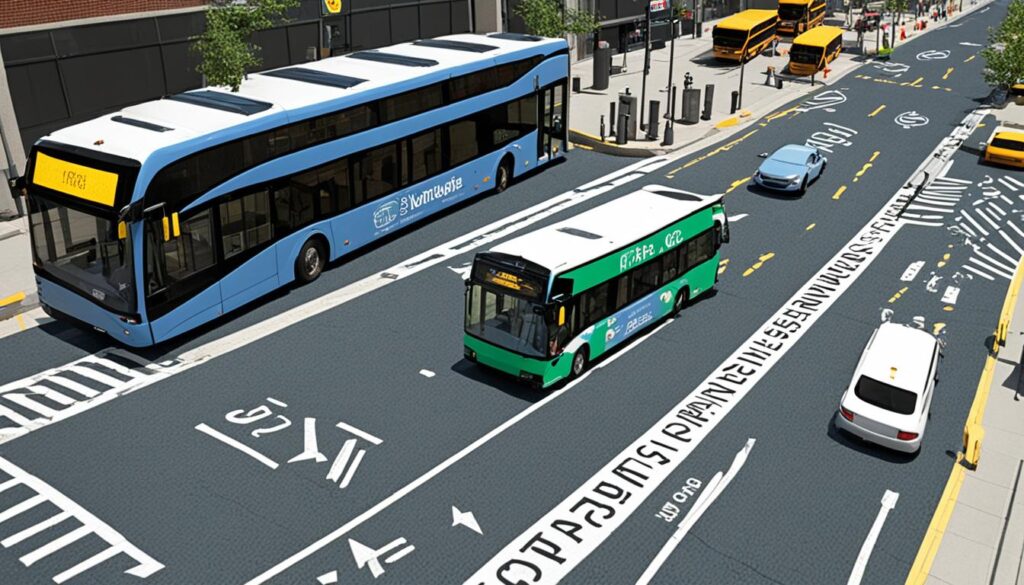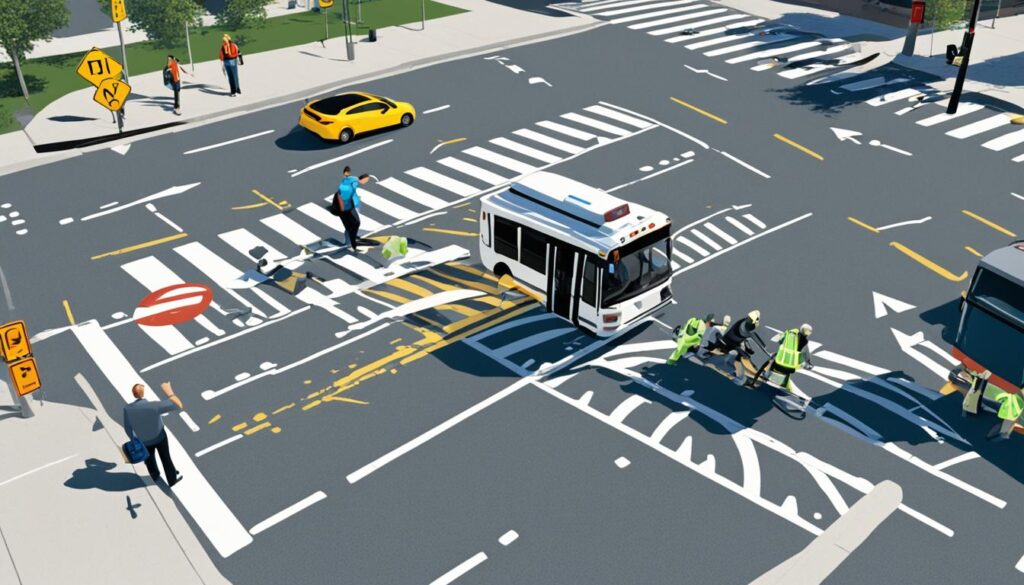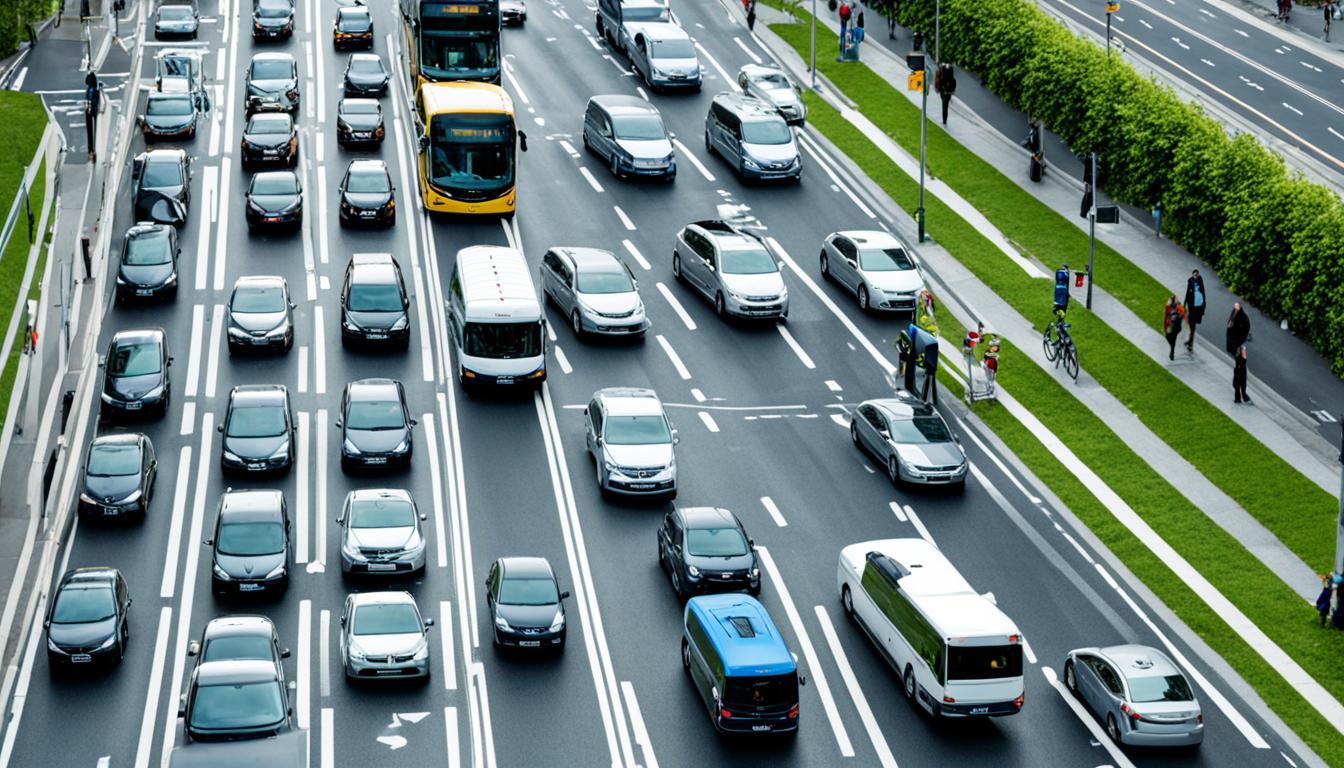Special purpose lanes such as bus lanes, bike lanes, tram lanes, and transit lanes are specifically designated for certain types of road users. When it comes to the bus lane, it’s essential to know who is allowed and who isn’t.
In the bus lane, the following road users are permitted:
- Buses
- Taxis
- Hire cars (limousines)
- Emergency vehicles
It’s important to note that motorcycles and personal mobility devices are not permitted in the bus lane. To ensure compliance, always check the signs that identify the bus lane and familiarize yourself with the specific bus lane regulations.
Key Takeaways:
- The bus lane is designated for specific road users.
- Allowed road users in the bus lane include buses, taxis, hire cars, and emergency vehicles.
- Motorcycles and personal mobility devices are not permitted in the bus lane.
- Always check the signs and familiarize yourself with the bus lane regulations to ensure compliance.
Bus Lane Regulations in Australia
Bus lane regulations play a crucial role in ensuring smooth traffic flow and efficient use of road space. These regulations specify who can use the bus lane and under what circumstances. In Australia, bus lane usage is primarily reserved for buses, taxis, hire cars, and emergency vehicles, allowing them to travel unimpeded even during peak hours.
Private ride-share cars, such as Uber vehicles, and private buses are not allowed to utilize the bus lane. These restrictions are put in place to prioritize the movement of public transport and emergency vehicles, reducing congestion and enhancing road safety.
To ensure compliance with bus lane regulations, it is essential for drivers to familiarize themselves with the rules and guidelines set forth by the relevant state or territory. Although the basic principles remain consistent across the country, there may be slight variations in bus lane regulations between different regions.
By adhering to the specific bus lane policies in each state or territory, drivers can contribute to a more efficient and organized transportation system. Let’s explore the bus lane regulations in some of the major Australian states:
| State/Territory | Bus Lane Regulations |
|---|---|
| New South Wales | Buses, taxis, hire cars, and emergency vehicles are allowed in the bus lane. |
| Victoria | Similarly to New South Wales, buses, taxis, hire cars, and emergency vehicles have access to the bus lane. |
| Queensland | Buses, taxis, hire cars, and emergency vehicles are permitted to use the bus lane without any restrictions. |
| Western Australia | Buses, taxis, hire cars, and emergency vehicles have priority in bus lanes. |
| South Australia | Bus lanes are exclusively reserved for buses and emergency vehicles. |
It is important for drivers to stay informed about bus lane regulations when traveling across state lines to ensure compliance with the specific requirements of each region. By respecting bus lane restrictions, drivers can contribute to the efficiency of public transport systems and enhance road safety for all road users.
Now that we have looked at the bus lane regulations in Australia, let’s dive deeper into the usage of bus lanes for bicycles in the next section.
Bus Lane Usage for Bicycles
When it comes to bus lane usage, bicycles are often allowed to share the road with buses and other authorized vehicles. However, it is important for cyclists to recognize the distinction between bike lanes and bus lanes.
In most cases, bicycles are permitted in the bus lane, but it is crucial to check for signs that specifically identify the lane as a bus lane. Bike lanes, on the other hand, are marked lanes dedicated to bike riders and are not always the same as bus lanes. Therefore, it is important for cyclists to exercise caution and ensure they are using the correct lane.
When entering a bus lane, bicycles need to yield to buses and other authorized vehicles. This ensures a smooth flow of traffic and minimizes the risk of accidents. It is also essential for drivers to be aware of the presence of bicycles in the bus lane and exercise caution when overtaking them.
By obeying the rules and guidelines for bus lane usage, both cyclists and drivers can safely navigate the roads, promoting efficient transportation and enhancing road safety for all.
Bus Lane Usage for Motorcycles
Motorcycles are a common sight on Australian roads, and many riders wonder about the rules and regulations surrounding their use of bus lanes. In general, motorcycles are allowed in the bus lane, providing they do not enter a lane that is specifically marked for buses only. However, it’s important for motorcyclists to be aware of any restrictions or limitations imposed by their state or territory.
When using the bus lane, motorcyclists should exercise caution and prioritize safety. It is crucial to give way to buses and other authorized vehicles, as they have a larger size and lower maneuverability in congested traffic. By being mindful of their surroundings and respecting the presence of buses, motorcyclists can ensure a smooth flow of traffic in the bus lane.
Adhering to the designated bus lane usage rules not only promotes a safer road environment but also helps to alleviate congestion by enabling efficient traffic flow. Remember, bus lanes are intended to prioritize the movement of public transportation and emergency vehicles, so it’s important to respect their purpose while enjoying the benefits of motorcycle travel.
Bus Lane Usage for Other Vehicles
In the bus lane, private cars and trucks are generally not permitted to drive. The bus lane is specifically designated for authorized vehicles such as buses, taxis, hire cars, and emergency vehicles. However, there are some exceptions to this rule.
In certain situations, private vehicles may be allowed to use the bus lane for a limited distance. For example, when entering or leaving the road, private cars and trucks can use the bus lane for up to 100 meters. This allows them to safely merge into or exit the flow of traffic.
Private vehicles may also use the bus lane to overtake a vehicle turning right or avoid an obstacle in the regular lanes. These exceptions help to ensure the smooth and efficient flow of traffic.
It is important for drivers of private cars and trucks to understand and obey the rules and regulations specific to each state or territory regarding the usage of the bus lane. Ignoring these rules can result in fines and penalties.
Key Takeaways:
- Private cars and trucks are generally not allowed in the bus lane.
- Exceptions include using the bus lane for up to 100 meters when entering or leaving the road, overtaking a vehicle turning right, or avoiding an obstacle.
- Drivers must adhere to the rules and regulations specific to each state or territory regarding bus lane usage.
By understanding and following these guidelines, drivers can ensure safe and legal usage of the bus lane, contributing to smoother traffic flow and improved roadway access rights for all road users.
| Authorized Vehicles Allowed in the Bus Lane | Unauthorized Vehicles Not Allowed in the Bus Lane |
|---|---|
|
|
Penalties for Misuse of the Bus Lane
Misuse of the bus lane can have serious consequences, including penalties and fines. It is crucial to understand and adhere to the rules and regulations of the bus lane to avoid violations and ensure the safety of all road users.
If a vehicle is found to be using the bus lane illegally, the driver may be subject to penalties and fines. The exact amount of the fine may vary depending on the state or territory where the violation occurred. These penalties are in place to deter drivers from unlawfully entering and obstructing the bus lane, ensuring efficient traffic flow and prioritizing the needs of public transport.
Bus lane violations can result in more than just financial consequences. They can also lead to increased congestion, delays for buses, and inconvenience for other road users. By respecting the rules of the bus lane, drivers contribute to a safer and more effective transportation system.
Consequences of bus lane violations:
- Bus lane penalties and fines
- Possible demerit points on the driver’s license
- Increased traffic congestion
- Disruption of public transportation services
It is vital to remember that bus lanes are specifically designated for authorized vehicles, guaranteeing efficient public transport operations. By obeying the bus lane regulations, drivers play a role in enhancing the overall functionality of the road network.
The misuse of bus lanes can result in disruptions to the public transportation system, compromising its ability to operate efficiently. By adhering to the rules and regulations, drivers can help ensure smooth traffic flow and reliable journeys for all road users.
To avoid bus lane penalties and fines, drivers should familiarize themselves with the bus lane regulations in their respective states or territories. By understanding which vehicles are permitted to use the bus lane and the specific circumstances under which entry may be allowed, drivers can mitigate their chances of violating the rules.
Benefits of complying with bus lane regulations:
- Improved traffic flow
- Efficient public transportation services
- Reduced congestion
- Enhanced road safety
Ensuring the appropriate use of bus lanes not only benefits public transportation but also contributes to a safer and more sustainable transport system for all road users. Compliance with bus lane regulations is essential for a well-functioning road network.
Remember, respecting the bus lane regulations is not just about avoiding penalties; it is about promoting a culture of responsible driving and prioritizing the needs of public transport. Let’s work together to create a safer and more efficient transportation system for everyone.
Bus Lane Regulations Across Different States and Territories
While the basic rules for bus lane usage are similar across Australia, there may be some variations in regulations between different states and territories. It is important to familiarize yourself with the specific bus lane regulations of the state or territory you are driving in.
Some states may have additional restrictions or requirements for bus lane usage, such as specific times of operation or exemptions for certain types of vehicles. Consulting the local road authority or government website can provide the most up-to-date information on bus lane regulations in a particular area.
Examples of State-Specific Bus Lane Regulations
Here are some examples of how bus lane regulations may vary across different states and territories:
| State/Territory | Bus Lane Restrictions | Additional Regulations |
|---|---|---|
| New South Wales (NSW) | No private vehicle access | Bus lanes operate 24/7 |
| Victoria (VIC) | No private vehicle access during peak hours | Bus lanes may have specific hours of operation |
| Queensland (QLD) | No private vehicle access during peak hours | Bicycles may be allowed in some bus lanes |
| Western Australia (WA) | No private vehicle access during peak hours | Bus lanes may have specific hours of operation |
These examples illustrate how bus lane regulations can differ from state to state. It is crucial to stay informed about the specific rules and regulations in your area to avoid any potential violations or fines.
By understanding and adhering to state-specific bus lane regulations, drivers can ensure a smooth and safe flow of traffic in the bus lane, contributing to efficient roadway access rights for all road users.

Understanding Bus Lane Signs
When driving on the roads, it is essential to understand and familiarize yourself with bus lane signs and road markings. These signs play a crucial role in identifying and indicating the presence of a bus lane, ensuring that drivers comply with the corresponding regulations.
Bus lane signs provide essential information about the specific road users permitted in the bus lane, the times of operation, and any additional restrictions or requirements. By paying attention to these signs and following the instructions provided, drivers can avoid violations and contribute to a smooth flow of traffic in the bus lane.
The identification of bus lane signs is vital for all motorists. For instance, signs may display specific icons or symbols representing buses, taxis, or emergency vehicles, indicating their authorized usage of the bus lane. Understanding these signs will help drivers recognize the designated lane and act accordingly to avoid any violations.
“By paying attention to bus lane signs and following the instructions provided, drivers can avoid violations and contribute to a smooth flow of traffic in the bus lane.”
In addition to signs, road markings also play a significant role in bus lane identification. These markings typically consist of solid white lines on the road surface, indicating the boundaries of the bus lane. These markings help drivers distinguish between regular lanes and the dedicated bus lane.
To ensure compliance with bus lane regulations and avoid penalties, drivers must be aware of these signs and markings. Additionally, taking the time to familiarize yourself with the specific bus lane regulations of the state or territory you are driving in will further enhance your understanding and adherence to the rules.
Tips for Recognizing Bus Lane Signs
Here are some tips to help you recognize and understand bus lane signs:
- Pay attention to road signs and markings specifically indicating the presence of a bus lane.
- Familiarize yourself with the icons or symbols representing buses, taxis, and emergency vehicles.
- Take note of any additional restrictions or requirements displayed on the signs.
- Remember that bus lane signs may vary slightly between different states or territories, so always check the local regulations for the area you are driving in.
By following these tips and remaining observant on the road, you can ensure your compliance with bus lane regulations and contribute to a safer and more efficient traffic flow.
Tips for Safe and Legal Bus Lane Usage
When utilizing bus lanes, it is crucial for drivers to prioritize safety and adhere to the law. To ensure safe and legal bus lane usage, consider the following tips:
- Familiarize yourself with bus lane regulations: Each state or territory in Australia may have slightly different bus lane regulations. Take the time to understand the specific rules and guidelines in the area you are driving in. This will help you navigate the bus lane effectively and avoid any violations.
- Always check the signs: Look out for signage that identifies the bus lane. These signs will indicate the specific road users allowed in the lane, any time restrictions, and any additional requirements. By paying attention to the signs, you can ensure you are using the bus lane appropriately.
- Give way to authorized vehicles: Buses and emergency vehicles have priority in the bus lane. Make sure to yield to these authorized vehicles when entering or sharing the lane. This will help maintain a smooth flow of traffic and prevent any potential collisions.
- Exercise caution with bicycles and motorcycles: Bus lanes may also be shared with bicycles and motorcycles in certain circumstances. Be aware of their presence and exercise caution when overtaking or sharing the lane with them. Respect their space and give them enough room to maneuver safely.
- Avoid stopping or parking: Unless specifically authorized to do so, refrain from stopping or parking in the bus lane. This will help prevent congestion and ensure that buses and other authorized vehicles can navigate the lane without obstruction.
By following these tips, you can ensure that you are using the bus lane safely, legally, and in consideration of other road users. Always prioritize safety and be aware of the rules that govern bus lane usage in your area.

| Violation | Possible Penalties |
|---|---|
| Unauthorized use of bus lane | Financial fine, demerit points on your license |
| Stopping or parking in the bus lane | Financial fine, towing of the vehicle |
| Failure to yield to authorized vehicles | Financial fine, demerit points on your license |
Conclusion
In conclusion, the bus lane regulations in Australia aim to provide efficient and reliable transportation for specific road users. Buses, taxis, hire cars, and emergency vehicles are allowed to use the bus lane at any time, ensuring smooth transit for these essential services. Additionally, bicycles and motorcycles are generally permitted in the bus lane, granting flexibility to alternative modes of transport. However, private cars and trucks are restricted from using the bus lane, with a few exceptions such as entering or leaving the road and overtaking a vehicle turning right.
To ensure safe and legal usage of the bus lane, drivers must familiarize themselves with the relevant bus lane regulations of the state or territory they are driving in. By adhering to the specified rules and guidelines, drivers not only avoid penalties but also contribute to improving roadway access rights for all road users. It is crucial to understand and follow bus lane regulations to maintain efficient traffic flow and ensure the safety of everyone on the road.
In summary, the bus lane regulations prioritize public transportation and emergency services while accommodating bicycles and motorcycles. Private cars and trucks are generally restricted from the bus lane, as they may hinder the smooth operation of these vital services. By complying with the bus lane regulations and sharing the road responsibly, drivers can contribute to a safer and more efficient transportation system in Australia.
